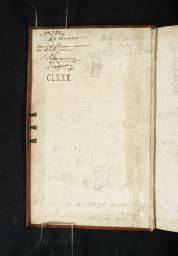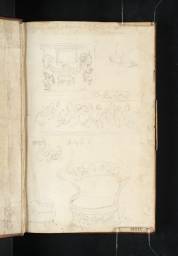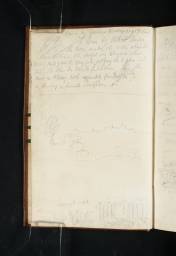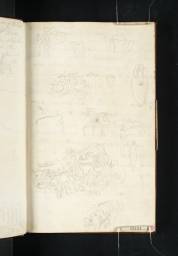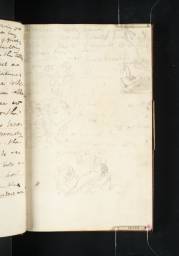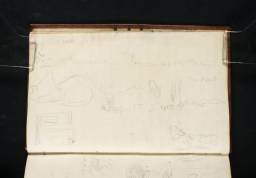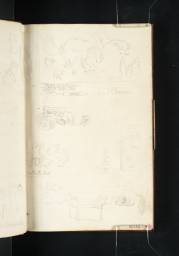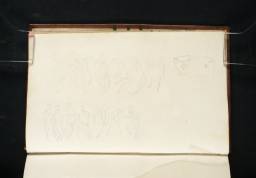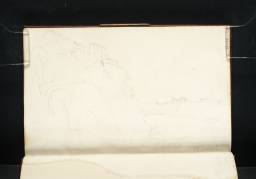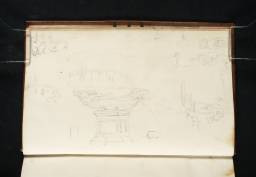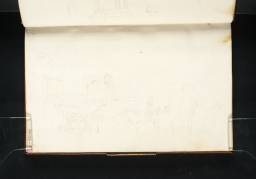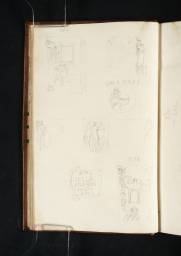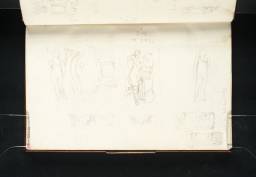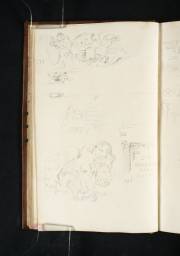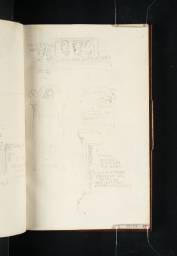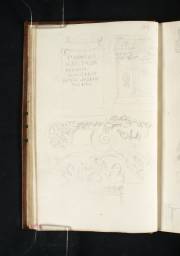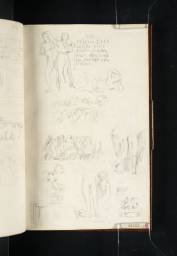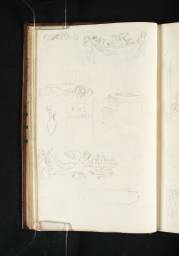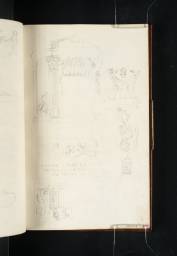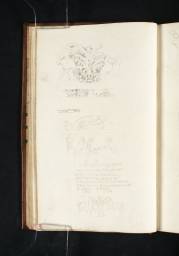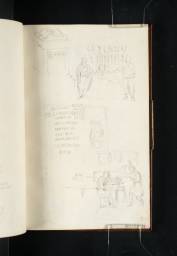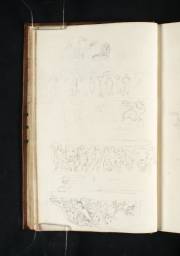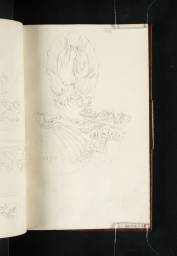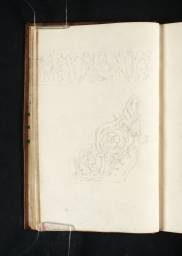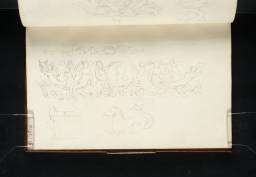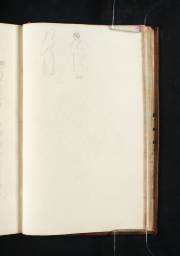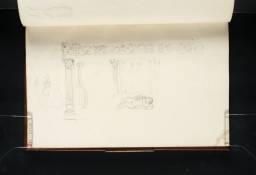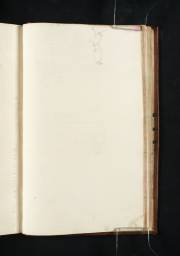Turner Bequest CLXXX
Sketchbook with brown leather covers, and brass clasp fastening [clasp is missing]
82 leaves of white wove writing paper, approximate page size 161 x 101 mm
Made by John Jones and John Mather, Afonwen Mill, Denbigh, North Wales; various pages watermarked ‘[Prince of Wales feathers] | J ... [monogram] | 18 ... ’ and pages prepared with grey wash watermarked ‘J Whatman | 1816’
82 leaves of white wove writing paper, approximate page size 161 x 101 mm
Made by John Jones and John Mather, Afonwen Mill, Denbigh, North Wales; various pages watermarked ‘[Prince of Wales feathers] | J ... [monogram] | 18 ... ’ and pages prepared with grey wash watermarked ‘J Whatman | 1816’
Inscribed by the artist in ink on the back cover ‘Vaticano’ along top (almost illegible). Finberg also notes a label on the back of the sketchbook inscribed by the artist ‘16. Vatican fragments’, now missing / detached.
Stamped in black ‘CLXXX’ top right
Stamped in black ‘CLXXX’ top right
Accepted by the nation as part of the Turner Bequest 1856
Exhibition history
References
Turner used this sketchbook during his first tour of Italy in 1819, one of twenty-three related to that trip, and one of nine employed during his stay in Rome, which aside from some weeks spent travelling to Naples and Paestum, lasted between early October to December or early January 1820.1 John Ruskin described it as a ‘Book of Roman Architectural detail. Very interesting’.2 As the title given by the artist suggests, the majority of the book is comprised of sketches of sculptural fragments in the Vatican Museums, although it also contains studies from the Palazzo Corsini, Palazzo Farnese, and the Capitoline Museums.
Turner’s interest in antique sculpture formed a substantial part of his visual exploration of Rome. Like all artists of his generation, the study of plaster casts of antique sculptures had formed the basis for his training at the Royal Academy Schools (see for example Tate D00056; Turner Bequest V C), and his interest in the classical world evolved as he matured. It is not surprising therefore that he seized the opportunity during his first Italian tour for a protracted first-hand survey of antique works of art. As Cecilia Powell has discussed, his interests were wide-ranging, incorporating free-standing sculpture and ornamental details from buildings and monuments, but his particular fascination was for details of sculptural relief such as those found on sarcophagi, altars, gravestones and vases.3 He indiscriminately recorded famous and obscure examples alike, and in many cases he copied the accompanying Latin or Greek inscriptions as well as the visual forms, although his comprehension of their meanings must have been very limited. Studies of sculptural and architectural fragments appear throughout his Italian sketchbooks, but the principal focus for his attention was Rome and the collections of the Vatican and Capitoline Museums. The sketches he made there in 1819 provided the artist with source material and inspiration for many years and appear to have informed his depiction of antiquities in finished oil paintings such as the statuary in What you Will! exhibited 1822 (Sterling and Francine Clark Art Institute, Williamstown, Massachusetts)4 and Phyrne Going to the Public Baths as Venus – Demosthenese Taunted by Aeschines exhibited 1838 (Tate, N00522).5 Jerrold Ziff described the sketchbook as ‘nearly a dictionary or pattern book of motifs’.6 James Hamilton has also suggested the Vatican sculptures more generally stimulated his creative invention, for example, within the multitudinous figures of Christ Driving the Traders from the Temple circa 1832 (Tate, N05474) which resemble some of the complex compositions on Roman sarcophagi.7
According to contemporary guidebooks, the Vatican Museums were only open to the public twice a week but it was possible to obtain access at other times by producing a note from the Italian sculptor, Antonio Canova (1757–1822), President of the Accademia di San Luca and Inspector General of Antiquities and Fine Arts for the Papacy.8 Turner’s request was placed with Canova at the behest of his friend and fellow Royal Academician, the portrait painter, Sir Thomas Lawrence (1769–1830), who was in Rome between May 1819 and January 1820.9 Lawrence wrote to Canova in early October 1819:
A letter from Mr. Hope will I believe introduce to you this morning Mr. Turner, our finest landscape painter. A man of the most powerful the most elegant and comprehensive genius in his art, that has been known in Europe since the days of Claude. I do not idly say this in mere compliment to him, but I give it to you as what I know to be the unanimous opinion of the Members of the Royal Academy in England of which Institution he is one of the Professors. I should have left the introduction to him to the sufficient testimony of our Friend Mr. Hopi [sic], but that I wished to mention to you the probable time of his visit; which I think he intends should be Ten o’clock this morning. He is unacquainted with the Italian Language so that your kindness will be put to another trial. Will you oblige him with an order to the Keepers of the Musée to permit him to sketch from fragments statues etc.10
Francis Chantrey (1782–1841), who saw and dined with Turner in Rome on 15 November, two days before departing for London, reported to Joseph Farington on his return that Turner was ‘much occupied in the Vatican in drawing Capitals &c., and was very industrious’.11
At the time of Turner’s visit the Vatican Museums were still evolving and growing. The Museo Chiaramonti, housing classical antiquities, had recently been established at the beginning of the nineteenth century but the Museo Braccio Nuovo was still under construction and not open until 1822.12 Many famous works of art including Raphael’s Transfiguration, the Apollo Belvedere, the Belvedere Torso and the Laocoön, which had been removed to the Louvre during the French occupation of Rome, had only recently been brought back in 1815 and 1816 under the supervision of Canova, and in 1819 the Pinacoteca (Picture Gallery) was given a new arrangement in the Borgia Apartments.13 A contemporary account of a visit to the Vatican Museums and Palace in 1819 outlines the route taken by the public during the early nineteenth century.14 Visitors would enter by the Portone di Bronzo and ascend the Scala Regia, to the Sala Regia, from where they would visit the Sistine Chapel, the Pauline Chapel and the Appartamento Borgia (then the Pinacoteca, or Picture Gallery). From here, the first Loggia crossed to the Galleria Lapidaria (Gallery of Inscriptions), the Vatican Library and the Biblioteca Chiaramonti. It was then necessary to retrace part of the route to the Sala di Sansone, where the print collection was installed, the Museo Braccio Nuovo, the Museo Chiaramonti and the Cortile della Pigna. Ascending to the first floor, visitors would then enter the Museo Pio-Clementino, and pass through the so-called Galleria delle Miscellanee (now known as the Galleria dei Candelabri), the Galleria delle Carte Geografiche, the Rooms with the Tapestries of Raphael (Apartment of St. Pius V) and lastly the Stanze and Logge of Raphael. Although the route today has changed, many of the collections, particularly within the Museo Pio-Clementino, remain in the same position as the nineteenth-century layout which Turner saw.
The extensive but somewhat sporadic nature of the Vatican sketches suggests that Turner must have been to the Museums on more than one occasion, with his visits possibly straddling either side of his journey to Naples between mid-October and mid-November. Furthermore, since he was granted special permission to visit the Museums outside of the usual opening hours, it seems probable that he would not have been entirely bound to the official route but had more freedom to visit the rooms which interested him most. Finally, a separate project appears to have been Turner’s focused interest in the Loggia of Raphael in the Vatican’s Apostolic Palace, the drawings for which appear in the Tivoli and Rome sketchbook (see Tate D14955–D14966 and D14969–D14972; Turner Bequest CLXXIX 13a–21a and 24–26). Many of the Vatican Fragments studies, however, relate to objects traditionally found in the Museo Chiaramonti and the Lapidary Gallery, a long gallery built by Bramante on the second floor of the Vatican which contains the epigraphic collections of thousands of ancient inscriptions. He also explored the Museo Pio-Clementino which was comprised of several galleries, each with a distinct character, such as the Sala degli Animali (Gallery of Animals), Sale delle Muse (Gallery of the Muses), Gabinette delle Maschere (Cabinet of Masks) and the Cortile Ottagono (Octagonal Gallery, also known as the Cortile del Belvedere). In addition to sketching individual objects, he also made a couple of views of entire rooms (see folios 36 verso–7, 48 and 48 verso; D15173–4, D15196 and D15197; Turner Bequest CLXXX 35a–36, 47 and 47 verso), similar to the manner of some of James Hakewill’s plates for Picturesque Views in Italy, published 1820.15 It was his practice to annotate his studies with the contemporary exhibit numbers of the works, although these do not appear to correspond to any known lists published within contemporary guide books or catalogues of the Vatican collections.
The Capitoline Museums represented a smaller collection than the Vatican, and the continuous, focused nature of Turner’s sketches there suggests that they were probably executed on a single visit (see folios 53 verso–59; D15207–18; Turner Bequest 52a–8). The main object of his attention was the Palazzo Nuovo, the palace located on the left of the Piazza del Campidoglio which houses an important collection of antique sculpture. Inaugurated as a public museum in 1733, the ancient marble statues are displayed according to a typological criteria as well as aesthetic principles, so that rooms are often thematically organised around a central masterpiece, for example the Sala di Fauno (Hall of the Faun) and Sala dei Filosofie (Hall of Philosophers). Turner’s visit to the museum followed a recent reorganisation of the rooms in 1816 when the return to Rome of works spoliated by Napoleon occasioned a new layout. The artist inscribed some of his studies with the contemporary exhibit numbers of the objects, corresponding to this new arrangement, first published in Agostino Tofanelli’s, Catalogo delle sculture antiche e de’quadri esistenti nel Museo e Galleria da Campidoglio (1817). Powell has suggested that Turner often started a fresh sketchbook page upon entering a new room.16 She says his route began in the Galleria, worked his way along the smaller rooms from the Sala degli Imperatori to the Sala del Gladiatore and ended up in the Stanza del Vaso.17
In addition to studies of antique sculpture, the Vatican Fragments sketchbook also contains a number of views of Rome and several other places which form part of the established nineteenth-century route between Rome and Naples, for example, Lake Nemi, Tor Tre Ponti, Terracina, Fondi and Formia. There is also at least one prospect of Naples itself, see folio 34 verso (D15169; Turner Bequest CLXXX 33a). These sketches are randomly scattered throughout the book and although it is not certain whether they represent the outward or return leg, they repeat locations depicted in the southward Gandolfo to Naples sketchbook (Tate; Turner Bequest CLXXXIV), and so may constitute the journey back. The gate at Terracina, for example, is seen on the southern approach as though travelling north in the direction of Rome, see folio 77 verso (D15240; Turner Bequest CLXXX 76a). Further sketches relating to the return journey between Rome and Naples can be found in the Albano, Nemi, Rome sketchbook (Tate; Turner Bequest CLXXXII) and the Naples, Paestum, Rome sketchbook (Tate; Turner Bequest CLXXXVI). Various written inscriptions within the book also provide rare documentary evidence of Turner’s movements and encounters during his time in Italy. The inner back cover contains suggestions for hotels and restaurants in Naples by an unknown hand, whilst another page bears the addresses of two people Turner met during his travels; Captain Graham (husband of Maria Graham, later Lady Callcott) and the architect Thomas Leverton Donaldson (1795–1885), see folio 82 verso (D15250; Turner Bequest CLXXX 81a).
The other sketchbooks containing Roman subjects are Albano, Nemi, Rome (CLXXXII), Tivoli and Rome (CLXXIX), Naples: Rome C. Studies (CLXXXVII), St Peter’s (CLXXXVIII), Rome: C. Studies (CLXXXIX), Small Roman C. Studies (CXC), Rome and Florence sketchbook (CXCI), and Remarks (Italy) (CXCIII) (all Tate, Turner Bequest). Despite its title, the Naples, Paestum and Rome (CLXXXVI) sketchbook does not appear to contain any views of the city and the Route to Rome sketchbook (CLXXI) contains notes but no identified sketches.
Ziff 1965, p.64 note 30; Butlin and Joll 1984, no.229, reproduced pl.232, and in colour in Powell 1987, colour pl.11, p.[64].
Letter from Sir Thomas Lawrence to Antonio Canova, 8/9 October 1819, published in Hardy George, ‘Turner, Lawrence, Canova and Venetian art’, Apollo, October 1996, p.30.
See Carlo Fea, Nuova descrizione de’monumenti antichi e oggetti d’arte contenuti nel Vaticano e nel Campidoglio, Rome 1819, described in Pietrangeli 1993, p.167.
Technical notes
How to cite
Nicola Moorby, ‘Vatican Fragments sketchbook 1819’, sketchbook, December 2009, in David Blayney Brown (ed.), J.M.W. Turner: Sketchbooks, Drawings and Watercolours, Tate Research Publication, December 2012, https://www

